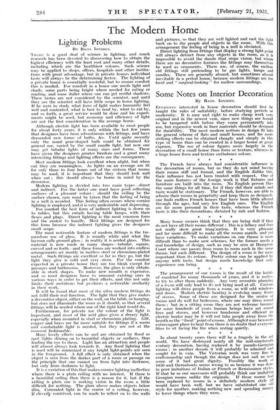Some Notes on Interior Decoration By B.1SII. IONIDES.
EVERYONE interested in house decoration should first he taught the rules of suitability, before studying periods or modernity.- It is easy and right to make cheap work very original and in the newest vein, since new. things are bound to be tampered with before they come permanently into use, but expensive work in finer materials should be designed for durability. The most modern notions in • design fit into the general scheme of flats and small houses, and far more striking effects can be obtained cheaply and simply in this type of home than can be created in a larger house at great expense. The use of colour figures more largely in the decoration of-a small honse: than form or texture, whereas in a large house form and texture outbalance colour.
- * * * *
The French- have always had considerable influence in the decoration of rooms, but as they do not mind having their rooms stiff and formal, and the English dislike this, their influence has not been treated with respect. One of the main 'features • of the foreign work- is that fixtures and furniture are built into the room. No English person likes the same things for all time,, for if they did their minds and taste would be stationary. The French, however, are able to admire their rooms in perpetuity and keep them as designed : one finds endless French houses that have been little altered through the ages, but very few English ones. The English are far more personal in their taste, whereas the French taste is like their decoiatkins, dictated by rule and fashion.
*. *
Many house owners think that they are being dull if they do not have all their rooms different ; this is a fallacy and does not really show great imagination. It •-is very pleasant and far more difficult to make all the rooms match, and yet have variations. To make variations on one theme is more
difficult than to, new schemes, for the former needs a real knowledge o design, such as may be seen at Hampton Court where one passes from room to room each in the same theme, but each different. The design of a room is far more important than its colour. Pretty colour can be applied by anyone with taste, but design needs knowledge that only experience can bring.
*
The arrangement of our rooms is the result of the habit4 of mankind for many thousands of years, and it is useles, to try to alter them suddenly. Any very eccentric planning of a room will only lead to its not being used at all. Curious lighting will drive people from a room, as will odd windows and doors. Modern electric heating is evolving many forms of stoves. Some of these are designed for the centre of rooms and do well for bedrooms, where one may dress round them ; but in a sitting room they are not welcome because for some hundreds of years human beings haire sat round fires and stoves, and however handsome and efficient an electric heater may be it will not take people away from the hearth as the " focal " point of a room. Although it may be a more extravagant place to heat from there-is no doubt that everyone likes to sit facing the fire when resting quietly.
In about twenty years there will be a tragedy in the ad world. We have destroyed nearly all the mid-nineteenth century decoration, having replaced it by pseudo-Georgian rooms : in another decade it will probably be admired and sought for in vain. The Victorian work was very fine in craftsmanship and though the design does not suit us now some of it had great dignity. Possibly the work of 1850 and thereabouts seems wrong to us because it was done in poor imitations of Italian or French or Renaissance styles- If that be so our successors will probably think our imitation Georgian rooms unlike the originals. If these rooms had been replaced by rooms in a definitely modern style all would have been well, but we have substituted one old style for another, making nothing new and spending mono) to leave things where they were.











































 Previous page
Previous page